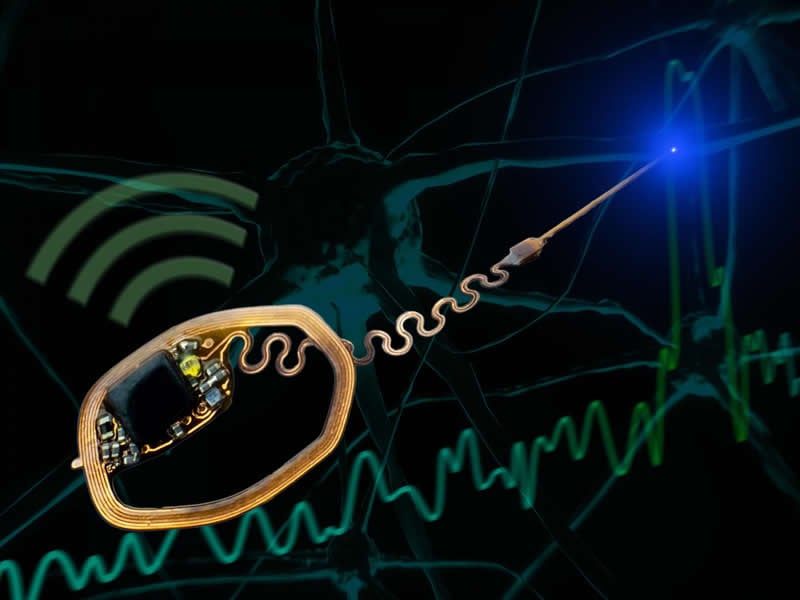Summary: Neuroengineers have created an ultra-small, wireless, battery-free device that uses light to record individual neurons. The device will give researchers a new platform to gain insight into the underpinning mechanisms of the brain.
Source: University of Arizona College of Engineering
The mammalian brain is the most complex organ in the body, capable of processing thousands of stimuli simultaneously to analyze patterns, predict changes and generate highly measured action. How the brain does all this – within fractions of a second – is still largely unknown.
Implants that can probe the brain at the individual neuron level are not widely available to researchers. Studying neuron activity while the body is in motion in an everyday setting is even more difficult, because monitoring devices typically involve wires connecting a study participant to a control station.
Researchers at the University of Arizona, George Washington University and Northwestern University have created an ultra-small, wireless, battery-free device that uses light to record individual neurons so neuroscientists can see how the brain is working. The technology is detailed in a study in the Proceedings of the National Academy of Sciences.
“As biomedical engineers, we are working with collaborators in neuroscience to improve tools to better understand the brain, specifically how these individual neurons – the building blocks of the brain – interact with each other while we move through the world around us,” said lead study author Alex Burton, a University of Arizona biomedical engineering doctoral student and member of the Gutruf Lab.
The process first involves tinting select neurons with a dye that changes in brightness depending on activity. Then, the device shines a light on the dye, making the neurons’ biochemical processes visible. The device captures the changes using a probe only slightly wider than a human hair, then processes a direct readout of the neuron’s activity and transmits the information wirelessly to researchers.
“The device is smaller than a single M&M and only one-twentieth of the weight,” Burton said.
The device can be tiny, and even flexible like a sheet of paper, because it does not need a battery. It harvests energy from external oscillating magnetic fields gathered by a miniature antenna on the device. This allows researchers to study brain activity without the use of restrictive equipment and gives neuroscientists a platform to gain insight into the underpinning mechanisms of the brain.

“When creating the device, we used materials and methods that are readily available and cheap enough to enable large-scale adaptation of the tool by the scientific community,” said study senior author Philipp Gutruf, who leads the Gutruf Lab and is an assistant professor of biomedical engineering and member of the university’s BIO5 Institute. “We hope that the technology can make a difference in fighting neurodegenerative diseases such as Alzheimer’s and Parkinson’s and cast light on the biological mechanisms, such as pain, addiction and depression.”
Source:
University of Arizona College of Engineering
Media Contacts:
Emily Dieckman – University of Arizona College of Engineering
Image Source:
The image is credited to University of Arizona Gutruf Lab.
Original Research: Closed access
“Wireless, battery-free subdermally implantable photometry systems for chronic recording of neural dynamics”. Alex Burton, Sofian N. Obaid, Abraham Vázquez-Guardado, Matthew B. Schmit, Tucker Stuart, Le Cai, Zhiyuan Chen, Irawati Kandela, Chad R. Haney, Emily A. Waters, Haijiang Cai, John A. Rogers,Luyao Lu, and Philipp Gutruf.
PNAS doi:10.1073/pnas.1920073117.
Abstract
Wireless, battery-free subdermally implantable photometry systems for chronic recording of neural dynamics
Recording cell-specific neuronal activity while monitoring behaviors of freely moving subjects can provide some of the most significant insights into brain function. Current means for monitoring calcium dynamics in genetically targeted populations of neurons rely on delivery of light and recording of fluorescent signals through optical fibers that can reduce subject mobility, induce motion artifacts, and limit experimental paradigms to isolated subjects in open, two-dimensional (2D) spaces. Wireless alternatives eliminate constraints associated with optical fibers, but their use of head stages with batteries adds bulk and weight that can affect behaviors, with limited operational lifetimes. The systems introduced here avoid drawbacks of both types of technologies, by combining highly miniaturized electronics and energy harvesters with injectable photometric modules in a class of fully wireless, battery-free photometer that is fully implantable subdermally to allow for the interrogation of neural dynamics in freely behaving subjects, without limitations set by fiber optic tethers or operational lifetimes constrained by traditional power supplies. The unique capabilities of these systems, their compatibility with magnetic resonant imaging and computed tomography and the ability to manufacture them with techniques in widespread use for consumer electronics, suggest a potential for broad adoption in neuroscience research.






